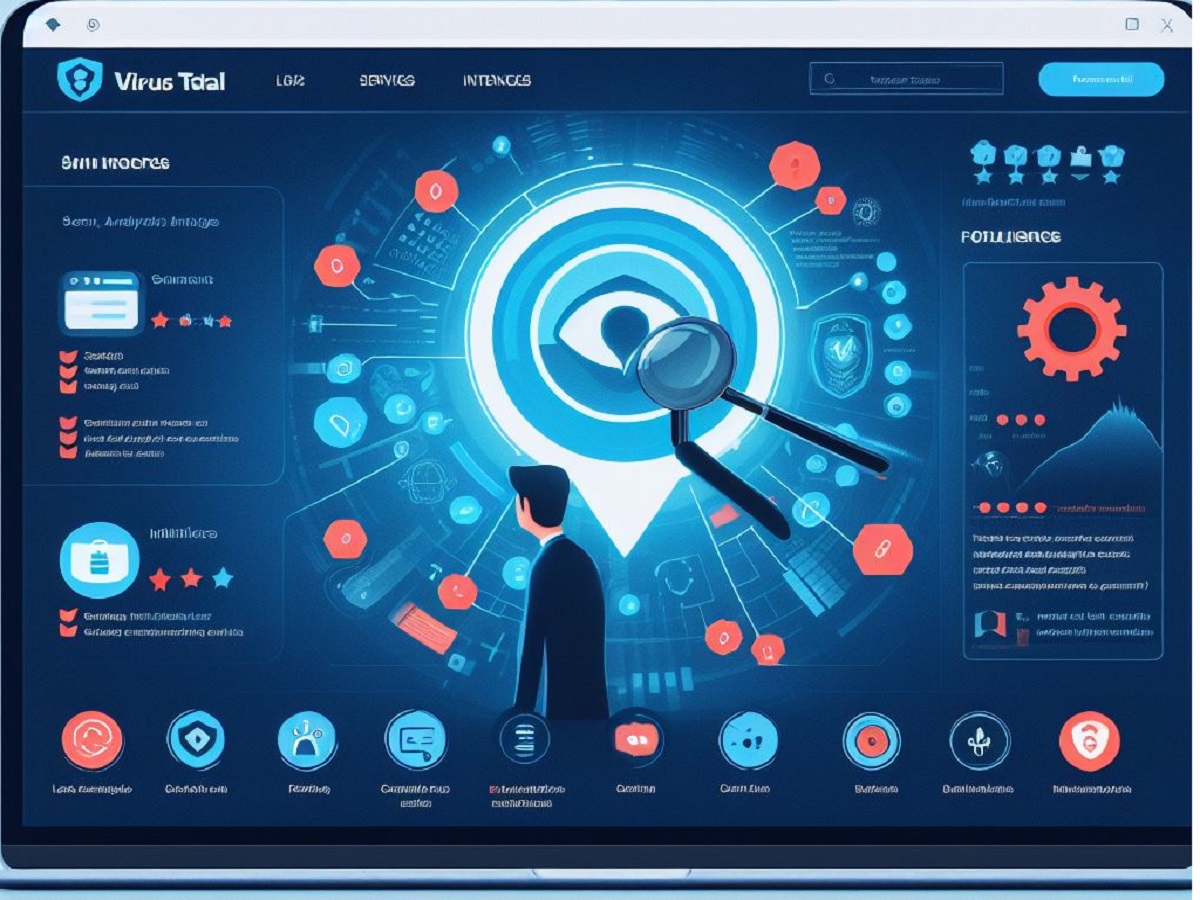Virustotal is a well-known online service that allows users to submit files and URLs for analysis to check for potential malware and security threats. It operates by employing multiple antivirus engines to scan and assess the safety of digital content. Since its acquisition by Google in 2012, Virustotal has become a popular tool in cybersecurity and is trusted by many. However, its reliability has been a subject of debate and scrutiny. In this extensive examination, we will delve into the intricacies of Virustotal, evaluating its reliability, strengths, and limitations.
Virus Total’s Role in Cybersecurity
Before delving into its reliability, let’s first establish Virustotal’s role in cybersecurity. Virustotal is a cloud-based service designed to scan and analyze files and URLs. Users can easily submit a file or link through its user-friendly interface, and Virustotal subsequently runs the submission through a battery of antivirus engines. The service then aggregates and presents the results to the user, giving them a sense of the potential security risks associated with the submitted content.
Analyzing Virustotal’s Reliability
To evaluate the reliability of Virustotal, we must consider several key aspects:
Detection Rate
The detection rate is a crucial aspect of reliability. It refers to Virustotal’s ability to identify malicious content accurately. The service’s strength lies in using multiple antivirus engines, theoretically improving detection rates. However, it is essential to recognize that not all antivirus engines are created equal. Their effectiveness varies based on their techniques and their detection signatures. Consequently, the detection rate provided by Virustotal can be inconsistent.
False Positives
In the world of cybersecurity, a false positive occurs when a legitimate file is incorrectly flagged as malicious. This can lead to significant consequences, including blocking access to essential files and causing unnecessary panic. The occurrence of false positives is a concern because it undermines the reliability of Virustotal.
False Negatives
False negatives, on the other hand, refer to the situation in which a malicious file is erroneously labeled as safe. This is equally concerning because it allows malware to infiltrate systems undetected. The reliability of a cybersecurity tool like Virustotal should be closely scrutinized in terms of its ability to avoid false negatives.
Timeliness
The reliability of Virustotal is also contingent on how promptly it updates its database with new virus definitions and detection methods. Cyber threats continuously evolve, and malware authors continually update their creations to evade detection. If Virustotal needs to update its databases, it may become less effective in identifying the latest threats.
Sample Size
Another factor that significantly impacts the reliability of Virustotal is the diversity and volume of the samples it handles. A more extensive and varied sample pool increases its ability to detect both known and emerging threats. However, this aspect is challenging to assess because it depends on the volume and variety of files and URLs users submit.
Strengths of Virustotal
Despite the ongoing debates regarding its reliability, Virustotal offers several significant strengths:
Aggregated Results
One of Virustotal’s strengths is its ability to provide aggregated results from multiple antivirus engines. This approach allows users to assess the consensus among these engines. Users can gauge the risk associated with a particular file or URL by doing so.
User-Friendly Interface
Virustotal’s user-friendly interface is a valuable asset. It makes the service accessible to technically savvy users and individuals who may not have extensive cybersecurity expertise. The ease with which users can submit files and URLs for analysis enhances its practicality.
Community Engagement
Virustotal encourages community involvement by allowing users to comment on and discuss the results of analyses. This communal aspect provides additional context and insight, which can be especially helpful when assessing the reliability of detection.
Historical Data
Virustotal retains historical scan results, allowing users to track how the reputation of a file or URL has changed over time. This historical data can be useful in understanding the evolution of potential threats and can provide a nuanced view of reliability.
API Integration
For organizations and advanced users, Virustotal offers an API that allows integration of its functionality into their systems. This API enables automated scanning of files and URLs, streamlining the process of security assessments and further enhancing its reliability in certain contexts.
Limitations of Virustotal
To provide a balanced perspective, it’s crucial to acknowledge Virustotal’s limitations:
Varying Detection Rates
Multiple antivirus engines can lead to varying detection rates for the same file or URL. Different engines employ different techniques, which can result in discrepancies in scan results. Users may find it challenging to determine the actual nature of a file or URL based on these varying results.
Lack of Context
Virustotal’s primary function is to provide raw scan results but doesn’t offer contextual information or analysis. Interpreting these results requires a degree of expertise in cybersecurity. Users must know what the presence of detection means and how to weigh the likelihood of false positives and negatives.
Limited URL Analysis
While Virustotal excels at file analysis, its URL analysis capabilities could be more robust. It may not detect phishing sites or other web-based threats as effectively as dedicated URL analysis tools. This limitation can affect its reliability when assessing the safety of web links.
No Remediation
Virustotal is fundamentally a diagnostic tool, not a remediation tool. It cannot remove or clean malicious files or URLs. Users must look elsewhere for tools or methods to address and resolve security threats detected through Virustotal.
License Restrictions
Some antivirus engines used by Virustotal may have license restrictions that impact their functionality or the accuracy of their detections. These license-related restrictions can introduce an element of unpredictability into the results provided by the service.
In-Depth Analysis of Reliability
Detection Rate
The reliability of Virustotal’s detection rate is contingent on the effectiveness of the antivirus engines it employs. These engines employ various techniques to identify malware, including signature-based detection, heuristics, and behavioral analysis. However, it’s essential to recognize that only some techniques are foolproof, and the effectiveness of each engine can vary significantly.
False Positives and False Negatives
The issue of false positives and false negatives is intricately tied to the detection rate. False positives can be problematic because they can lead to unnecessary concerns and inconveniences for users. On the other hand, false negatives are more concerning, as they allow malicious content to go undetected, potentially resulting in security breaches.
Timeliness
The reliability of Virustotal is also influenced by how promptly it updates its antivirus engines and definitions. In the dynamic field of cybersecurity, threats are continually evolving. Cybercriminals are adept at updating their malware to avoid detection. If Virustotal needs to update its databases, it may become less effective in identifying the latest and most sophisticated threats.
Sample Size
The effectiveness of Virustotal’s analysis is directly related to the size and diversity of the sample pool. A larger and more diverse sample pool increases the likelihood of detecting known and emerging threats. However, assessing this aspect is challenging as it depends on the volume and variety of files and URLs submitted by users.
User Experience and Practical Considerations
Virustotal’s user-friendly interface is one of its standout features. It allows technical and non-technical users to submit files and URLs for analysis easily. The clear presentation of results simplifies assessing potential security risks associated with digital content. This user-friendliness enhances its practicality, making it accessible to a broad audience.
Furthermore, Virustotal encourages user engagement through comments and discussions on analysis reports. This collaborative aspect of the service provides additional context and insight. Users can share information, experiences, and interpretations of the results, contributing to a more comprehensive view of the reliability of a given detection.
The retention of historical data is another valuable aspect of Virustotal. It enables users to track how the reputation of a file or URL has evolved. This historical perspective can be instrumental in understanding the dynamics of potential threats and the reliability of assessments made by the service.
Virustotal’s API integration is a notable feature for organizations and advanced users. It allows for the automation of file and URL scanning, streamlining the process of security assessments. This API can be harnessed to enhance the reliability of security checks in various contexts.
Understanding the Limitations
Despite its strengths, Virustotal is not without its limitations:
Varying Detection Rates
Virustotal’s use of multiple antivirus engines can lead to varying detection rates for the same file or URL. Different engines employ different techniques, which can result in discrepancies in scan results. Users may find it challenging to determine the actual nature of a file or URL based on these varying results.
Lack of Context
Virustotal’s primary function is to provide raw scan results but doesn’t offer contextual information or analysis. Interpreting these results requires a degree of expertise in cybersecurity. Users must know what the presence of detection means and how to weigh the likelihood of false positives and negatives.
Limited URL Analysis
While Virustotal excels at file analysis, its URL analysis capabilities could be more robust. It may not detect phishing sites or other web-based threats as effectively as dedicated URL analysis tools. This limitation can affect its reliability when assessing the safety of web links.
No Remediation
Virustotal is fundamentally a diagnostic tool, not a remediation tool. It cannot remove or clean malicious files or URLs. Users must look elsewhere for tools or methods to address and resolve security threats detected through Virustotal.
License Restrictions
Some antivirus engines used by Virustotal may have license restrictions that impact their functionality or the accuracy of their detections. These license-related restrictions can introduce an element of unpredictability into the results provided by the service.
Conclusion
Virustotal is a valuable tool in the realm of cybersecurity, offering users the ability to assess the potential security risks associated with files and URLs. Its strengths, including aggregated results, user-friendliness, community engagement, historical data, and API integration, make it a practical choice for many users. However, it also comes with limitations, such as varying detection rates, a lack of context in results, limited URL analysis, and no remediation capabilities.
The reliability of Virustotal depends on several factors, including its detection rate, the occurrence of false positives and false negatives, timeliness in updating databases, and the size and diversity of the sample pool. Users should be aware of these factors and use Virustotal with other security measures to ensure a comprehensive approach to cybersecurity.
In the end, Virustotal can be a valuable tool in a cybersecurity arsenal, but it should not be the sole determinant of the safety of digital content. Users must exercise caution, employ best practices in cybersecurity, and consider the service’s strengths and limitations to make informed decisions about the reliability of its assessments.

